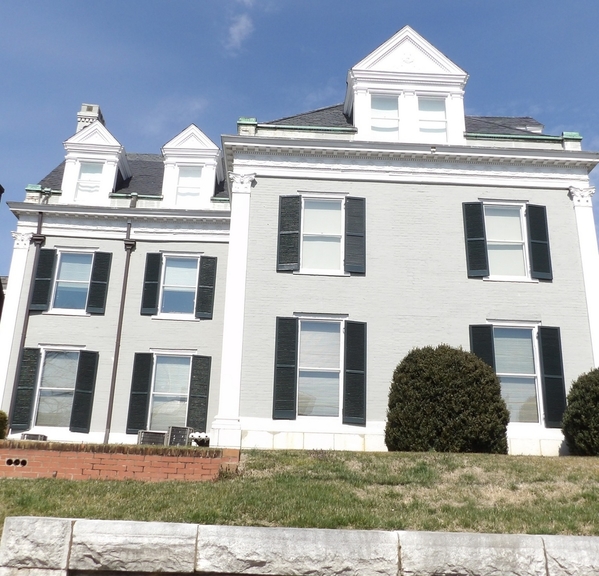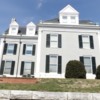Where Gumbo Was #316
Formerly the Woodrow Wilson Birthplace Foundation was established in 1938 and dedicated by President Franklin D. Roosevelt in 1941. It was registered as a National Landmark in 1965 (but its metal plaque says 1964) and the Museum was added in 1990 and the WWI Trench Exhibit in 2010 along with a new library in 2011. The Presbyterian Manse, a brick structure a couple houses up from the WWPL was where President Wilson was born in 1856.
Congratulations to Michael Fong II and Roderick Simpson, who correctly identified this as the answer to this week's Where in the World!
Last year, over 22,000 individuals visited the WWPL from all 50 states and 19 countries. It is a privately funded museum that does not receive federal or state funding. The League of Friends members provide the bulk of support funds along with paying visitors. The days and hours of operation can vary with the seasons, so it’s recommended to check online. General admission is $14 adults, $12 seniors/military, $7 students, and $5 for kids ages 6-12. There are a number of group and personalized tours that you can investigate online.
The City of Staunton is located in the Shenandoah Valley in between the Blue Ridge and Allegheny Mountains of the Appalachian Mountains. It is at the intersection of Interstates I-81 and I-64 and an approximate drive of 2 hours from the Virginia capital of Richmond and 3 hours from Washington DC. I will provide more details on the sights in the City of Staunton in a future Gumbo blog.
The WWPL is located at 20 North Coalter Street with plenty of free street parking and public park lots around town. The building itself was named “The Delores Lescure Center” in honor of the President of the Woodrow Wilson Birthplace Foundation for 20 years. At the museum entrance I was given a warm greeting by Ms. Robin von Seldeneck, WWPL President and CEO after mentioning the TravelGumbo connection.
Woodrow Wilson’s father was a Presbyterian pastor at the Staunton church and a year later his wife Janet gave birth to their son Thomas Woodrow Wilson. Later, after moving to Augusta Georgia and Columbia South Carolina, Woodrow Wilson attended and graduated from Princeton University and his desk is an item on display in the museum. He later was named president of Princeton University when he was a professor there.
After graduating from Princeton, he then attended the University of Virginia and practiced law for a short time then achieved his PhD at John Hopkins University in Baltimore becoming the only US President to receive a doctoral degree. His doctoral dissertation “Congressional Government” earned him the first John Marshall Prize which is on display in the museum. He also was a professor at Bryn Mawr College and Wesleyan College.
In 1885 he married Ellen Axon of Rome Georgia and they had three daughters. A photo of Ellen and Woodrow in 1885 is on display along with a photo of his wife and three daughters … Margaret, Jessie and Eleanor.
Woodrow Wilson was elected Governor of New Jersey in 1910 (his desk is on display at the museum) then elected President of the United States in 1912 and re-elected in 1916 on the slogan “He kept us out of war.”
Another slogan he used was “America First.” In the 1912 election Wilson defeated former US Presidents, Howard Taft and Theodore Roosevelt who formed a third party called the “Bull Moose” party.
After the election, Woodrow Wilson cancelled the Presidential Inaugural Ball because he supposedly disapproved of modern dancing that was surely going to be on display at the ball. Shortly after entering office, his wife Ellen died of Bright’s Disease in 1914 and Woodrow Wilson then married Edith Galt in 1915.
Wilson advocated legislation to limit the workweek to an 8-hour, six day maximum for worker health. He probably would be aghast at the workweek hours and time off benefits our son receives as a worker in Denmark.
President Wilson also vetoed a bill to require a literacy requirement for immigrants, but Congress overrode his veto and the literacy requirement was enacted. He also backed out of a six-nation deal approved by his predecessor to lend China money to help them build railroads.
In April 1917, President Wilson declared war on Germany after a series of attacks on US ships and an effort by Germany to persuade Mexico to join them in the fight.
After the Allies won the war, President Wilson was the first US President to travel to Europe while in office. He wrote his famous 14 Points that would be a blueprint for a good peace agreement, and he spent 6 months in Europe trying to work out the peace accord in Paris. One of his points was to create a League of Nations which did get created and operate until 1946, but had little power.
It was later superseded by the United Nations. In the museum is an exhibit of trench warfare, propaganda posters, and quotes by President Wilson.
In 1919 he was given a Pierce Arrow Series 51 Limousine for use during and after his Presidency.
In 1921, Wilson returned to private life in Washington DC and died in 1924 and was buried at the Washington National Cathedral. The Pierce Arrow has been restored and on display in the museum.
An archeological dig called “Beneath The Garden” is being sponsored by James Madison University and other participants. Many of the uncovered artifacts are currently on display in a separate room in the museum.
After finishing the museum tour, I had a very nice lunch at the Yelping Dog Wine Bar which is just two blocks away and that I would highly recommend and was also recommended by my golf buddy whose daughter attended the Mary Baldwin College in Staunton. Yelping Dog had a nice selection of local, domestic and foreign wines plus a great selection of cheese and fruit platters plus some sandwiches.



Comments (1)